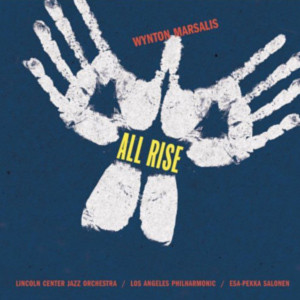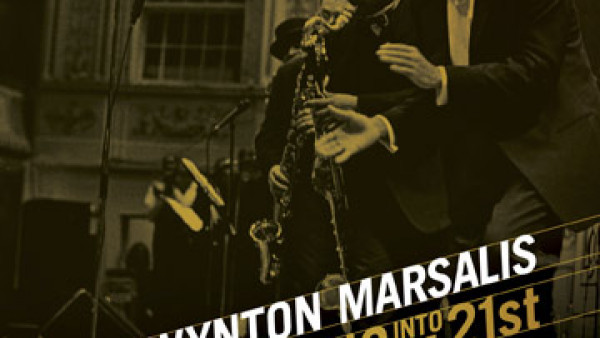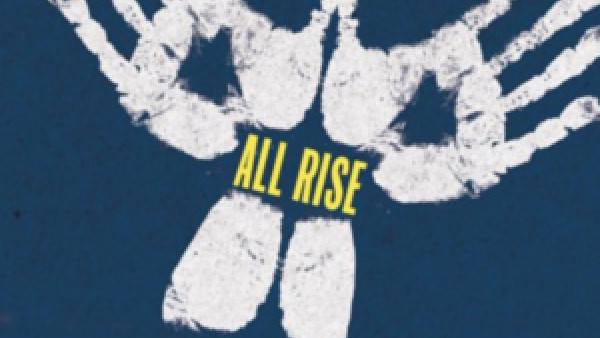Marathon Man. Anything but Conventional
With This Year’s Volcanic Musical Output, Wynton Marsalis Leads The Way Into The Next Millennium
The phone won’t quit ringing, the front door keeps swinging open and the parade of visitors never seems to stop. The scene, however, is not Grand Central Station. But it’s perhaps the second busiest spot in midtown Manhattan: Wynton Marsalis’ high-rise apartment near Lincoln Center, where he directs the most sweeping jazz performance program in the country, if not the planet.
Exactly how Marsalis manages to get anything done amid the perpetual swirl of activity in this place remains something of a mystery, even to his admirers. Yet from this comfortable but unpretentiously decorated aerie overlooking Broadway, Marsalis on this autumnal morning is brainstorming the release of eight new CDs and a seven-CD box set, conceiving grand plans for Jazz at Lincoln Center and penning his most ambitious composition to date, a 12-movement work for symphony orchestra, jazz band and 60-voice chorus to be unveiled Dec. 29 and 30 in Lincoln Center’s Avery Fisher Hall.
This relentless pace has made Marsalis the most recognizable living jazz avatar of the ’90s and helps explain why he has been voted Jazz Artist and Composer of the Year in the Down Beat Readers Poll. The miracle, though, is that he gets anything done amid the apparent mayhem.
“I’ll go over to Wynton’s house and there will be his kids in the den playing music, a football game on TV, two friends having a conversation, somebody in the kitchen cooking gumbo, and he’s at the piano, very seriously, with a pencil in his mouth, writing music, totally focused,” says Rob Gibson, executive producer and director of Jazz at Lincoln Center. “And the phone will ring five times in the 20 minutes that I’m there, and he’ll answer calls, and one of them will be about a record date, one of them will be ‘Call me back later,’ one of them will be some girl, and he’s doing all of that at once. In most people’s eyes it’s kind of wacky, but it really is the way he lives his life.”
Surely this lifestyle works for Marsalis, who draws energy from the seemingly chaotic forces gathered around him. Yet even by Marsalis’ hyperactive standards, 1999 has been uniquely busy, yielding not only the afore-mentioned wave of recordings but a remarkable series of world premieres. These include Marsalis’ elegant orchestrations for several Duke Ellington compositions, unveiled during a “Live From Lincoln Center” ‘TV broadcast in April on public television; the dance score “Them Twos,” performed by New York City Ballet in June; and the epic symphonic work in progress, “All Rise.”
Among these projects, none has bucked music-industry conventions more audaciously than the aforementioned new releases (15 CDs in all), surely a marketing executive’s nightmare. Promoting one recording, after all, is hard enough; persuading listeners to shell out hard-earned dollars for more than a dozen poses a considerably greater challenge.
“I decided to do it this past year [because] I had some of the music recorded, I knew that we were going to record more, and I just really wanted to get all my music out there,” says Marsalis, settling into a soft-cushioned sofa in a sun-drenched living room, his trumpet resting comfortably in his hands. “Not everyone [at Sony/Columbia] thought it was a good idea, but they were willing to work with me.
“To me, it’s a way of saying that it’s important for us, as musicians, to constantly fortify our position with music, to let each other know that, yeah, we’re still out here, putting out music,” adds Marsalis, whose eight-CD set, which alternated between the Columbia Jazz and Sony Classical labels, has been released one disc at a time under the overall banner “Swinging Into The 21st.”
“It’s important for me to make a statement of thanksgiving at this tum of the century,” he continues. “And whether you believe in it (the hoopla surrounding the new century) or not, the fact that so many people believe in it makes it true.
Putting out all this music at once is a way for me and the guys in the band to give thanks for the opportunity to come out and play, to show that we’re not squandering that opportunity.”
The very range of the music represented on the “Swinging Into The 21st” series (which includes everything from Igor Stravinsky to Jelly Roll Morton) and the Wynton Marsalis: Live At The Village Vanguard box set (with approximately 50 pieces) certainly suggests that Marsalis and friends hardly have been slacking off. Albums featured in “Swinging Into The 21st” include the evocative Mr. Jelly Lord: Standard Time, Vol. 6, an historically informed yet ultimately contemporary reading of Ferdinand “Jelly Roll” Morton’s classics; Big Train, a tour de force orchestral tone painting performed by Marsalis and his Lincoln Center Jazz Orchestra; and A Fiddler’s Tale, Marsalis’ cheeky reworking of Stravinsky’s “L’Histoire Du Soldat” in jazz, swing and blues idioms.
Live At The Village Vanguard, meanwhile, documents Marsalis’ septet (from 1990-‘94), an outgrowth of the sextet that he had led in the late ’80s. Drummer Herlin Riley articulates soulful rhythms, pianist Marcus Roberts (later replaced by Eric Reed) unfurls ancient-to-modem piano techniques, and reedists Wess Anderson and Todd Williams (the latter alternating with Victor Goines) create longing lyric phrases.
Without these musicians, as well as several others, Marsalis says, the strides he has made in his own music and at Lincoln Center would not have been imaginable. “The sound of the band is the sound of jazz. It’s not the sound of one man,” says Marsalis, who turned 38 on Oct. 18, while appearing with LCJO and the Chicago Symphony Orchestra in a week’s worth of subscription concerts in Symphony Center.
“One man can only do so much. That’s the first thing Marcus Roberts taught me when he came into the band [in 1985). He said, ‘You can’t make it out here alone. Period.’ “And that’s the truth. We all need to be held up.”
Roberts’ departure from the septet in 1991 foreshadowed the ensemble’s adjournment three years later: “It was almost like the heart of the band left with Marcus,” Marsalis explains. But the years with the sextet and septet surely taught Marsalis volumes about forging human and musical relationships. In other words, the cocky, outspoken young trumpeter who had become the talk of New York by 1981, when he was signed by Columbia, eventually learned how to build bridges rather than bum them. He applied these lessons shrewdly to the Jazz at Lincoln Center program, where Marsalis, Gibson and artistic advisers Albert Murray and Stanley Crouch transformed a fledgling jazz department into a full-fledged institution accorded the same status as the New York Philharmonic Orchestra and New York City Ballet.
But the most telling results of Marsalis’ gradual realization that he needed the help of others to accomplish great things has been in the Lincoln Center Jazz Orchestra, an ensemble that in many ways represents a musical extension of Marsalis’ much admired sextet/septet. The deep-blue shadings of the LCJO reed choir, the unusually lyric playing of the trumpet section and the propulsive swing energy of the rhythm section all evoke the sextet/septet – not surprising, since several alums of these bands (including Anderson, Goines, Wycliffe Gordon and Marsalis himself) hold chairs in the LCJO.
But if Marsalis and the $12 million-a-year Jazz at Lincoln Center program are well poised for the next millennium (with plans to open a new building at Columbus Circle in 2003), what about the precarious state of jazz itself in the MTV age? The most recent statistics collected by the Recording Industry Association of America (RIAA), a not-for-profit record-industry group, suggest that jazz claims a mere 1.9 percent of the market (down from 4.7 percent in 1988).
“Those numbers are just a way to demoralize musicians,” asserts Marsalis, not missing a beat. “Let’s look at all of what jazz has sold. Let’s tally up all of the sales of all jazz records from the beginning of time – why then you’ll see some truly interesting numbers. Jazz today is like a big mountain that has a volcano with hot molten lava that’s getting ready to pour out. And almost everybody acts like it’s not there, but they all know it is there.
“This music has exerted tremendous moral and intellectual pressure on our culture, and it continues to do that,” he adds, perhaps referring to the subtext of racial pride and affirmation that coursed through the music of Charlie Parker, the sense of optimism that marked recordings of Louis Armstrong and the unrepentant individualism that distinguished the work of Thelonious Monk, Miles Davis and others. “This music is never going to go away because a large number of our top young musicians always are attracted to jazz.”
Certainly Marsalis has done a great deal to nurture and pro-mote young talent, with Roberts Eric Reed, Nicholas Payton and Ro; Hargrove just a few artists who have benefited significantly from association with the trumpeter. In addition, hundreds of youngsters across the country have been inspired by Marsalis’ educational workshops and by the annual Essentially Ellington High School Jazz Band Competition and Festival at Lincoln Center.
If Marsalis seems unabashedly optimistic about the future of jazz in America, despite its slender sales figures, perhaps that’s due, at least in part, to the energetic young musicians who perpetually hover around him. They can be found practicing in his apartment darting around him at Lincoln Center; and otherwise imbuing his life with promising sounds of rising talent. Or perhaps Marsalis’ optimism owes to the buzz of musical activity that seems_ to follow in his wake, the perpetual action suggesting that progress is being made.
“He sleeps three or four hours a night,” Gibson says, “and he spends about 20 hours working. That’s how you get all those things done.”
Certainly Marsalis’ deep-in-the-trenches approach to promulgating jazz has given the art form more visibility than it had in the two decades preceding his arrival in the ’80s.
“I’ll tell you why I’m optimistic,” Marsalis says. “You just have to realize where we’ve been. And you can see where we’re going, and we definitely are heading up. We’ve been down, and we are definitely going up. Now it’s not perfect, that’s for sure. We’re constantly being told that we’re doing wrong and none of this [music] sells and nobody wants anything of quality – don’t be fooled by that.
“There’s a lot available today. Don’t think that all is lost. A few decades ago, everybody thought the world was going to end, that we were going to blow each other up. Now they realize we’re going to make it to 2000. “Or at least it seems like we’re going to make it.”
Just before the start of that signal year, Marsalis will be standing on the stage of Avery Fisher Hall, flanked by the massive forces of the New York Philharmonic Orchestra, the Lincoln Center Jazz Orchestra and the Morgan State University Choir. They’ll be performing “All Rise,” as philosophical a work as any Marsalis has penned to date.
If Marsalis’ “In This House, On This Morning” (1994) explored spiritual devotion and “Blood On The Fields” (1997) won a Pulitzer Prize for its insight into American racism, “All Rise” takes on an even vaster subject: the cycle of life itself. It confronts life’s bitter conflicts and sweet resolutions, its personal pain and collective glory. Though it will have no text per se (with the possible exception of one passage), the working titles of its 12 movements – “We Are Born In Joy,” “We Are Redeemed Through Sacrifice,” “We Build Great Monuments To God” – suggest a kind of majestic sermon in swing.
Marsalis’ challenge will be to channel these ideas through the massive, combined forces of a large classical orchestra, a traditional jazz band and an immense church choir. “He’s attempting to solve the problem that many composers have faced when you put a jazz orchestra and a symphony orchestra on stage together,” Gibson says. “Whether he solves it in this piece remains to be seen, but I do know that in his vision of this music, he can see solving this problem.” Each vignette, says Marsalis, will be musically free-standing, the piece in its entirety ultimately covering several stylistic genres, “something like what you would hear if you’d go to a John Philip Sousa concert at the turn of the century,” he says.
“Every movement has its own integrity, and each one is different. Sousa might have played 16 pieces on a program – one ragtime, another opera aria, a march, and a minstrel song or a cakewalk. That’s our [American] form.”
And that’s how Marsalis and a small army of performers will swing into the next millennium. “Not a night passes that I don’t thank the Lord for these opportunities and hope I’m not wasting them by just doing something that would be detrimental,” says Marsalis, who does not take his mission lightly. “And the older I get, the more precious it becomes to me, every concert we do.
“I’m just very grateful, man.”
Wynton’s Wisdom on…
Thelonious Monk: “With Monk, first you can feel his incorruptible integrity, Second, he created a model language that is not abstract. He was an eccentric, but his music is not eccentric at all. His music is very logical and very warm and humorous, soulful and swinging.”
Igor Stravinsky: “It’s interesting to work with Stravinsky’s music, because he works in small units [of pitches]. It’s not at all like a harmonic progression or even a theme, it’s very different – it’s a cell. What was intriguing was applying the language of the blues and New Orleans march rhythms to the type of traditional marches that Stravinsky used (in ‘L’Histoire Du Soldat’).”
Marcus Roberts: “He can play, but it’s more than just his playing. It’s his consciousness. He’s very evolved, and he’s funny, man. And then there’s. his attention to detail and themes, and the soulfulness of what he plays, and his belief in what he’s playing. He learned all those long pieces [with my sextet and septet], and he would be playing them [from memory) bet-ter than we would be reading them. He hasn’t yet been given his proper place out here, but he cannot be stopped.”
Herlin Riley: “He was the soul of our septet. He is so consistent and so much of a man and so secure in who he is that a lot of times you could take Herlin for granted, because he doesn’t force himself on you, but he’s always there.”
Joe Temperley: “That’s how you want to approach music, to be in music as long as he’s been in it and have that type of joy. And he gets that big beautiful sound on whatever instrument he’s playing. He plays soprano [saxophone], alto, baritone – it doesn’t make any difference what he’s playing, it always sounds like Joe Temperley.”
Teaching: “I love to teach the kids. My father taught kids. I’m grateful to be doing that. I don’t feel like anybody owes me anything. I owe them.”
Writing for ballet: “First of all, I do it because it keeps me from writing long pieces. You can’t write three hours of music for ballet – they tell you 30 minutes. But I also like integration of the arts. It stimulates a different part of your creativity.”
Televised jazz: “It’s very important, but it’s got to be on our terms. Every time you go on TV on other people’s terms, it’s better to not be on it. And most of the times when you’re on TV, it’s not on your terms.”
Becoming a musician: “There are lots of ways to. be a great musician. It’s not that you have to be Charlie Parker. You’re not going to be that, probably. But don’t feel demoralized, because the achievement you want is to create your own sound. That sound can be spoken in any language. Clarinetist Michael White has his own sound. Marcus Roberts has his own sound. That’s a great achievement.”
by Howard Reich
Source: Downbeat



